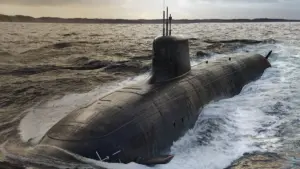Several members of the Senate Armed Services Committee sent a letter to President Biden this week asking for an update on the administration’s plan to implement the AUKUS agreement.
The AUKUS optimal pathway, announced
in March, entails the U.S. , U.K. and Australia cooperating to help Australia field nuclear-powered attack submarines to ultimately replace its Collins-class boats. (Defense Daily, March 13).

As part of the agreement, the U.S. expects to sell a mix of three to five new and used Virginia-class submarines in the early 2030s before the new SSN-AUKUS submarines will be ready for use by Australia by the early 2040s.
In the Oct. 17 letter, the senators specifically said they want the cost estimates within the Submarine Industrial Base (SIB) 2025 study, conducted by the Navy and Director of Cost Assessment and Program Evaluation. The administration does not plan to share the findings with Congress until the president’s fiscal year 2025 budget request is released next year.
“However, understanding the scope of the generational investment required for the SIB’s viability is critical for development of AUKUS-authorizing legislation this year and for robust Congressional oversight as the United States charts the future course of AUKUS,” the senators wrote.
The letter is signed by Senate Armed Service Committee Ranking Member Roger Wicker (R-Miss.) and other committee members Sen. Tim Kaine (D-Va.), Dan Sullivan (R-Alaska), Richard Blumenthal (D-Conn.), Kevin Kramer (R-N.D.) and Jeanne Shaheen (D-N.H.).
The letter asked for the cost estimate portion of the study to be provided by Oct. 31 “to inform Congressional consideration of any AUKUS-associated legislation.”
They also argued the SIB “will require significant resources” to improve submarine construction and maintenance rates to realize the potential of the AUKUS agreement.
“The volume of submarine tonnage the industrial base must produce to meet the Navy’s own requirements and fully implement the AUKUS agreement will require historic and sustained investments in the submarine workforce and supplier network. To achieve such capacity, Congress must have a comprehensive understanding of the current status of the submarine industrial base as well as the future resource investments necessary to meet our nation’s requirements,” they continued.
The senators also said the administration ultimately has to “articulate a detailed plan” to enact the enhancements needed to the submarine industrial base as a first step to addressing security challenges in the Indo-Pacific region and fully realize the goals of AUKUS.

Virginia-class submarines are built by both prime contractor General Dynamics’ Electric Boat [GD] and HII [HII] as a subcontractor, which divide the work.
The U.S. Navy has been buying two attack submarines per year, but the shipyards are not currently able to deliver at that rate. Australian officials have committed to providing $3 billion to help bolster the U.S. submarine industrial base. Ultimately, Australia seeks to work with U.S. and U.K. builders to create its own domestic nuclear-powered submarine construction and maintenance workforce.